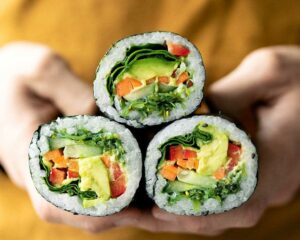“Although kimbap and sushi have similar shapes, they aren’t the same thing.”
Asiapramulia.com – Kimbap and sushi, two popular dishes from Korea and Japan, often look similar to each other. However, there are some key differences between kimbap and sushi that are important to know. Kimbap comes from Korea, while sushi comes from Japan. Kimbap began to appear in the early 20th century when Japan occupied Korea. Koreans love the Japanese food tradition of sushi and combine it with Korean ingredients and their own cooking techniques. On the other hand, sushi originates from Southeast Asia, where people started putting fish in fermented rice to increase its shelf life. Then, sushi became a dish that was liked by many people.
While sushi and kimbap (also spelled kimbap) may look similar at first glance, both featuring rice and ingredients wrapped in seaweed-they are actually quite different in terms of their ingredients, preparation methods, and cultural origins.
Source: TabloidNyata.com
Here are the key differences:
Origin
Sushi is Japanese, originating from Japan, and has a long history rooted in the country’s culinary traditions.
Kimbap (or Gimbap) is Korean, and it’s a popular dish in Korea, often served as a snack or lunch.
1. Rice
Sushi rice is seasoned with a mixture of vinegar, sugar, and salt, which gives it a distinctive tangy flavor.
Kimbap rice is typically mixed with sesame oil and salt, giving it a slightly nutty and savory taste.
2. Ingredients
Sushi is often made with raw fish (like tuna, salmon, or eel), seafood, and vegetables (such as avocado or cucumber). Some types of sushi (like nigiri) feature just the fish on top of rice, while others (like maki or uramaki) are rolled with rice and other fillings inside seaweed.
Kimbap usually contains cooked ingredients, such as beef, eggs, pickled radish, spinach, cucumber, and sometimes fish cakes or imitation crab. The focus is on cooked and pickled fillings, making it more accessible for people who may not eat raw seafood.
3. Preparation and Presentation
Sushi is often served as individual pieces, either rolled (maki) or pressed into small portions (nigiri). The fish or toppings are carefully placed on top of the rice or rolled into the seaweed.
Kimbap is almost always rolled into a long cylinder, cut into bite-sized pieces. The rolls are compact and uniform, making them easy to eat as a meal or snack.
4. Serving Style
Sushi is typically served with soy sauce, wasabi, and pickled ginger on the side. The emphasis is on the quality and freshness of the fish.
Kimbap is often eaten with kimchi or pickled radishes, and sometimes with a side of soup, especially in Korea. It’s considered a more portable, picnic-friendly food.
5. Cultural Context
Sushi has a more formal and ceremonial aspect in Japan, especially when served in fine dining or sushi bars.
Kimbap is a more casual, everyday food in Korea, often enjoyed during picnics, outings, or packed in lunch boxes.
In summary, the main difference lies in the type of ingredients (raw vs cooked), rice seasoning, and the cultural and regional variations in preparation and presentation. Though they share the concept of rice and seaweed, sushi and kimbap offer distinct culinary experiences.
Source: RRI.co.id





